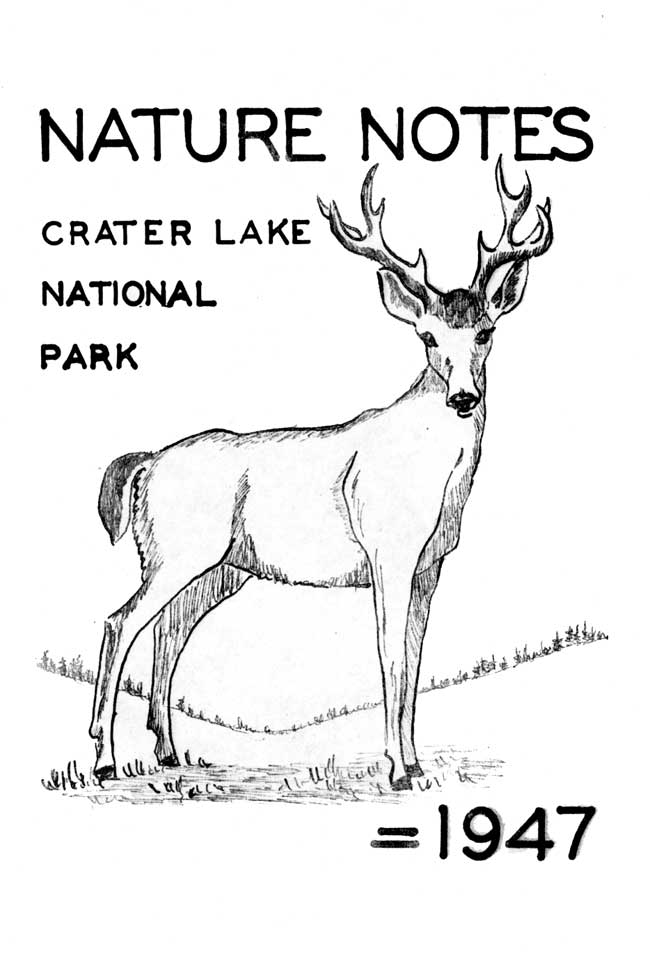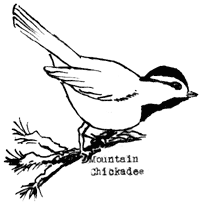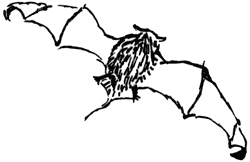Volume 13, October 1947
All material courtesy of the National Park Service. These publications can also be found at http://npshistory.com/
Nature Notes is produced by the National Park Service. © 1947
During three different summer seasons a mother Clark’s Crow, Nucifraga columbiana,has arrived on Crater Lake rim with a full grown but dependent young one. The 1942 pair, on which notes were taken, kept close to the parking area, the mother availing herself of the food offered by visitors and the young one calling incessantly to share in it.
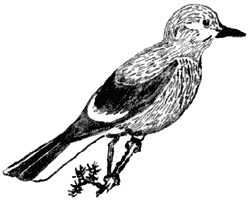 On July 13, 1947, the writer observed four Clark’s Crows on a table in the picnic area. One adult flew away leaving an adult with two full grown and clamorous offspring. The mother gleaned under the table for awhile, both young hopping after her with hunger cries. This perpetual clamor during the first part of July interested many people, most of whom appreciated the fact that they were observing a somewhat uncommon episode in family relations although few realized how unseasonal it was for a nutcracker to be feeding young that late in the year. In the morning, the mother usually exhibited considerable patience with her nagging offspring and fed it diligently. By afternoon, however, she appeared distinctly weary of well-doing, fed only at long intervals, and flew rapidly from one perch to another followed interminably by the squawking young one. At times she would administer a weaning peck or two which appeared to have little effect, and sometimes, when the youngster’s mouth was open, she would “feed him her bill clear down to the gizzard,” as one onlooker phrased it. This produced a sort of choking gurgle in the young one and greatly pleased visitors who were very tired of his clamor.
On July 13, 1947, the writer observed four Clark’s Crows on a table in the picnic area. One adult flew away leaving an adult with two full grown and clamorous offspring. The mother gleaned under the table for awhile, both young hopping after her with hunger cries. This perpetual clamor during the first part of July interested many people, most of whom appreciated the fact that they were observing a somewhat uncommon episode in family relations although few realized how unseasonal it was for a nutcracker to be feeding young that late in the year. In the morning, the mother usually exhibited considerable patience with her nagging offspring and fed it diligently. By afternoon, however, she appeared distinctly weary of well-doing, fed only at long intervals, and flew rapidly from one perch to another followed interminably by the squawking young one. At times she would administer a weaning peck or two which appeared to have little effect, and sometimes, when the youngster’s mouth was open, she would “feed him her bill clear down to the gizzard,” as one onlooker phrased it. This produced a sort of choking gurgle in the young one and greatly pleased visitors who were very tired of his clamor.
She then fed one young by regurgitation, ate again herself, and fed the second young crow in a similar manner. Occasionally, the mother fed both young in succession without eating between feedings. Both young accepted food with the typical feeding reaction of throaty noises and quivering wings. On July 18, 1947, three crows presumably the same trio, were in the camp grounds and going through the same maneuvers. The young made no effort to feed themselves when food was available.
To observe birds that nest, as a rule, in March, feeding young in the latter part of July is sufficiently unseasonal to be made a matter of record. In all three previous seasons in which it has been observed, the phenomenon was confined to one family. Data upon marked birds have shown that Clark’s Crows return to Crater Lake Rim for several years in succession so the observed adult may have been the same bird. She may nest much later than modally or she may rear an atypical second brood and bring one or more of them to the lake. Another possibility is that in a related group of birds the mother-young relationship is continued in time to a pathological degree and we are observing the distasteful antics of the crow problem child. In this connection, it may be recalled that problem children are an excrescence of the higher classes, a group, amongst avians, in which the crows belong. The idea should interest the philosopher who believes that the larger social groups are merely extensions of family relationships which were not, in themselves, particularly salutary. Other observations of mother-young interactions similar to those described above would be of interest in this connection.
Fox Sparrows Breeding on the Rim
By Dr. R. R. Huestis, Ranger-Naturalist
On July 30, Park Naturalist George C. Ruhle identified a fox sparrow, Passerella iliaca,sub. sp., on the rim walk just east of Crater Lake Lodge. The writer, who was a member of the field party being led by Mr. Ruhle, went back to the area on the morning of July 1 to see if the bird was still there. This special trip was prompted by knowledge of the fact that fox sparrows had not been reported even as transients in the rim area during the seven summers in which the writer has been a seasonally employed ranger-naturalist at Crater Lake National Park.
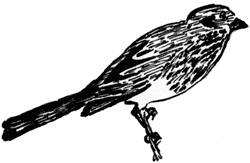 This female was carrying food and while the writer watched she signaled out of cover and fed a young bird apparently in juvenile plumage. After an interval of about two minutes the female reappeared with food, made contact with, and fed a young bird this time in the cover of a clump of small mountain hemlocks and herbaceous shrubs close to the rim walk. The observer was within twenty feet of the birds involved in these two important episodes in the lives of avian young.On July 1 at 8:30 A.M. a singing male, presumably the one identified by Mr. Ruhle, was seen on a small mountain hemlock close to the rim walk; near him was a female, presumably the second bird that was heard but not observed the previous day.
This female was carrying food and while the writer watched she signaled out of cover and fed a young bird apparently in juvenile plumage. After an interval of about two minutes the female reappeared with food, made contact with, and fed a young bird this time in the cover of a clump of small mountain hemlocks and herbaceous shrubs close to the rim walk. The observer was within twenty feet of the birds involved in these two important episodes in the lives of avian young.On July 1 at 8:30 A.M. a singing male, presumably the one identified by Mr. Ruhle, was seen on a small mountain hemlock close to the rim walk; near him was a female, presumably the second bird that was heard but not observed the previous day.
A prior report upon Passerella within Crater Lake National Park was made by Joseph Dixon who collected a fall migrant Valdez Fox Sparrow in 1936. The present family group was not broken to provide a bird in hand. The probability is that this report concerns P. I. fulva, Warner Mountains Fox Sparrow.
Rosy Finches
By Dr. R. R. Huestis, Ranger-Naturalist
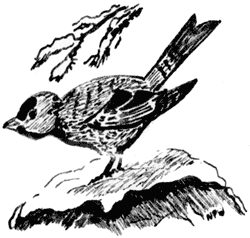 This notice is very often followed, when opportunity comes, by a question directed to a member of the park personnel. Even when visitors have heard of rosy finches they do not realize that, at last, they have seen one. This is because the vernacular name is inappropriate and, at least in Crater Lake National Park, these birds are not restricted to high altitudes. Visitors notice particularly the grey head and the large size for a finch. The usual comment is that the rest of the bird looked brown. On July 8, the members of a guided trip up the Garfield Peak trail were able to closely observe a pair of Hepburn’s rosy finches. The birds were feeding along a receding snowbank at 7800 feet, about twenty feet from the trail and paid no attention to the fifteen observers although these latter were quieter than any group of people unaccustomed to the conventions of successful bird observation. It is this tendency to continue with the business of feeding, as though observers did not exist, that brings the Leucosticte particularly to the notice of individuals who have taken advantage of self-guiding trails and are fortunate enough to come in contact with these handsome and by no means well-known birds.
This notice is very often followed, when opportunity comes, by a question directed to a member of the park personnel. Even when visitors have heard of rosy finches they do not realize that, at last, they have seen one. This is because the vernacular name is inappropriate and, at least in Crater Lake National Park, these birds are not restricted to high altitudes. Visitors notice particularly the grey head and the large size for a finch. The usual comment is that the rest of the bird looked brown. On July 8, the members of a guided trip up the Garfield Peak trail were able to closely observe a pair of Hepburn’s rosy finches. The birds were feeding along a receding snowbank at 7800 feet, about twenty feet from the trail and paid no attention to the fifteen observers although these latter were quieter than any group of people unaccustomed to the conventions of successful bird observation. It is this tendency to continue with the business of feeding, as though observers did not exist, that brings the Leucosticte particularly to the notice of individuals who have taken advantage of self-guiding trails and are fortunate enough to come in contact with these handsome and by no means well-known birds.
Actually, under field observation Leucostictes do not look rosy. According to Webster rosy means blooming; blushing; resembling a rose, and none of these connotations fits a hard working brown and grey finch busily working the snow banks. These finches are not large birds but they are bigger than the more commonly seen juncos, siskins, crossbills, and purple finches, and perhaps look bigger than they are because they are clearly seen against the snow.
No part of Crater Lake National Park is above 9000 feet but because snow commonly lies late in the angle which the rim makes with the lake shore and in sheltered points on the rim walls, Leucostictes may be seen along the lake shore at 6200 feet, along the crater wall trail which joins the rim at 7000 feet, and even just within the rim in the parking areas. Their visits to these latter points are transitory but to step from one’s car and only have to walk a few feet to see rosy finches is quite an event even if it doesn’t happen very often.
Birds of the Park in Winter
By Dr. G. C. Ruhle, Park Naturalist
It has long been held that the waxing and waning of food supply has been the chief cause of the migration of birds, but soon after the task of rearing a brood has been completed, scarcely after the last migrants have arrived in the park for the short summer season, and at a time when available food is most abundant with some species, the parent birds have grown restive and have started their long journey to climes with happier winters. By the time snow blankets the ground with a durable mantle, a dozen of the more than a hundred species of park birds remain to endure the icy winds, long snow storms, and drab days of the high mountain fastness. And of these, few individuals are seen by the ranger or skier who visits the park and enters the forest solitudes. Not one winter visitant species has been reported in the park.
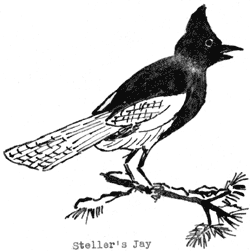 Closely related to the nutcracker is the Oregon or gray jay, the local representative camp robber or whiskey jack. This bird is bold and friendly, so most campers make its acquaintance. Its general appearance is unkempt, quite in contrast to the natty nutcracker, but this fluffiness helps to protect it from wintry cold. Like the other crows and jays, it nests early, in weather seemingly cold enough to freeze. On a trip by Sno-cat westward from the Watchman, we discovered its nest high under a protective canopy of green hemlock boughs. It was of twigs, moss, and lichen, snugly lined with grass and feathers, and deep enough so that only the head and tail of the brooding bird protruded. Best known of all park birds is the Clark nutcracker of intimate association with timberline forests of our West and with visitors to the lake rim in the summertime. He fares well at all times, since he eats a great variety of food, tho the seeds of conifers are his particular fare. In winter, he loiters around the park mess house, watchful for scraps of food and a possible handout. Most interesting is the fact that this gray crow, who spends his whole life in high mountains, nests in the dead of winter. The young are active and on the wing long before the flow of visitor traffic is underway in June.
Closely related to the nutcracker is the Oregon or gray jay, the local representative camp robber or whiskey jack. This bird is bold and friendly, so most campers make its acquaintance. Its general appearance is unkempt, quite in contrast to the natty nutcracker, but this fluffiness helps to protect it from wintry cold. Like the other crows and jays, it nests early, in weather seemingly cold enough to freeze. On a trip by Sno-cat westward from the Watchman, we discovered its nest high under a protective canopy of green hemlock boughs. It was of twigs, moss, and lichen, snugly lined with grass and feathers, and deep enough so that only the head and tail of the brooding bird protruded. Best known of all park birds is the Clark nutcracker of intimate association with timberline forests of our West and with visitors to the lake rim in the summertime. He fares well at all times, since he eats a great variety of food, tho the seeds of conifers are his particular fare. In winter, he loiters around the park mess house, watchful for scraps of food and a possible handout. Most interesting is the fact that this gray crow, who spends his whole life in high mountains, nests in the dead of winter. The young are active and on the wing long before the flow of visitor traffic is underway in June.
Crows and jays are the most intelligent of birds and many provide for lean months by hiding provender in times of abundance. In summertime, it is entertaining to watch nutcrackers thriftily cache peanuts and tidbits supplied by kind people on the rim, only to have the Steller jay lurk in the shadows to steal them from under his nose. For this handsome character of dark blue suit, black cowl, and jaunty crest, like many other jays, is an ungracious rogue always ready to cry an indignant, “Thief, thief!”, at the other fellow, is a self-righteous termagant skilled in vituperation that bristles with vilest of epithets and curses. He mixes freely with the blameless nutcrackers and camp robbers that come to our camp in winter squawking, “We’re hungry; how about some grub?” For the smoke hardly starts curling above our lonely showshoe cabin, before these forms appear in the trees or on the snow, where no life had been visible upon the arrival of the occupant.
Holding aloof from his three cousins above, as well as from members of his own kind, the big, solitary raven may sometimes be seen flying inside of the crater wall in any month of the year. He loiters, scolding around the garbage disposal area, or lurks at a distance from the mess hall. In the park, as elsewhere, he undoubtedly finds carcasses of victims of the storm, and he carries out his beneficial role of scavenger. Ravens nest early. The crags inside the rim furnish them with an abundance of nesting sites.
The biggest park bird is the bald eagle. Formerly very abundant in Oregon, this, our national emblem, has become uncommon. He is to be seen, winter and summer, soaring over the lake; perhaps his favorite item of food is fish, either, fresh or carrion. Eagles nest on Wizard Island; building a huge home of stick and twigs, with a lining of moss and plant materials.
The great horned owl is so-called from the prominent tufts of feathers that project above his eyes. He is an aggressive night hunter that lives on rabbits, squirrels, grouse, and other prey. A hardy bird, he nests early, sometimes taking over the empty homes of a raven or hawk. His penetrating hoot, an unforgettable nocturnal sound of western timberland, is heard, also, in winter months blended with the wail of winds and the creaking of trees.
Occasionally on ski trips in the park, one is startled by a sudden whirr of laboring wings, as one flushes a sooty grouse. These birds perform interesting tho limited seasonal migrations. They spend summer and fall on open ridges to feed on ripe berries and insects. In spring, they move downward to the edges of the meadows to nest. In winter, they keep to heavy timber, mostly unseen and high in the conifers, in which they feed on buds and needles. In March, males utter a low-pitched hoot which comes from a throat inflated until large brilliant yellow sacs show on either side of the neck. The birds are ventriloquists, and one scrutinizes with care, only to find, if lucky, that the performer perches at the very elbow of the searcher.
Among woodpeckers, only the Modoc hairy has been reported within the park in mid-winter. He has appeared outside the mess hall looking for crumbs. His relative, the red-shafted flicker, does not remain all year, but returns early to the park, his lusty call resounding in the early months of the year.
Cheeriest of all winter birds is the tiny mountain chickadee, whose rollicky chick-a-dee-dee-dee seems to be stimulated rather than stilled by the gruffest storms. Sometimes their gay company is sought by a nuthatch, but in the park in winter, such an observation is rare.
The water ouzel should spend winter within the park, since there is open water here, but there do not seem to be any reports of his presence. February is his month of brilliant song, which is heard over the gurgling of the complementary half-frozen stream that is his home.
With late February, days of sunshine become more frequent, and summer residents may soon put in appearance. Thus a blackbird has been reported at Annie Spring in February, and a meadowlark ten days later. As early as March, robins, mountain bluebirds, and varied thrushes may come in the vanguard of migrants and summer residents. Juncos arrive from the lowlands, the siskins chirp as they fly from tree to tree, the woodland rings with the nasal “yank! yank!” of nuthatches. Not until snow has all but disappeared, with the song of the axe ringing in camp grounds, do the last of the host, among them the olive sided flycatcher and the nighthawk, complete the cycle of the year.
Forster’s Tern
By Dr. Ruth E Hopson
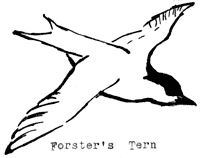 Post mortem examination revealed that she had not eaten for some time as no sign of undigested food was found in the digestive tract. Since these birds are known to nest in the marshes of Upper Klamath Lake, it is probable that this bird was lost in the storm and was unable to find suitable food in the unsuitable habitats afforded by the rugged southern Cascades of which Crater Lake National Park is a part. This tern is a marsh loving bird which is not conditioned to timbered areas.On June 7, a female Forster’s tern, Sterna forsteri, was found dead near the Lost Creek Ranger Station at the East Entrance to the park. It was evidently a casualty of the storms of the first week of June. Forster’s terns have not previously been reported within Crater Lake National Park; this specimen can only be regarded as accidental.
Post mortem examination revealed that she had not eaten for some time as no sign of undigested food was found in the digestive tract. Since these birds are known to nest in the marshes of Upper Klamath Lake, it is probable that this bird was lost in the storm and was unable to find suitable food in the unsuitable habitats afforded by the rugged southern Cascades of which Crater Lake National Park is a part. This tern is a marsh loving bird which is not conditioned to timbered areas.On June 7, a female Forster’s tern, Sterna forsteri, was found dead near the Lost Creek Ranger Station at the East Entrance to the park. It was evidently a casualty of the storms of the first week of June. Forster’s terns have not previously been reported within Crater Lake National Park; this specimen can only be regarded as accidental.
Renewal of Beaver Activity in Copeland Creek
By W. S. Vincent, Ranger-Naturalist
Early this season the crew clearing out the Caste Creek Firetrail observed that beaver were damming the culvert at Copeland Creek. Other park employees reported additional signs of renewed activity to the naturalist’s office. On July 2 and July 16 I visited the area with Ranger-Naturalist O. L. Wallis.
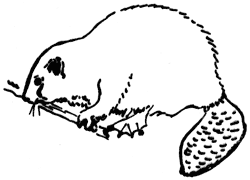 On July 16, it was noted that the willows have recovered. With their food supply replenished, the beavers have renewed activity along this stream. Nearly every one of the old dam sites had been or was in the process of being repaired. A considerable amount of water is being stored behind these dams in the area which extends about 250 yards below the firetrail. The restored dams range from five to fifty feet in width and from one to four feet in height. Behind one dam, the impounded water is backed up approximately one hundred feet. The total number of dams is about 15.Beaver had been very active in the Copeland Creek region for several years after 1931, when they first appeared in this section of the park. They soon exhausted the willows, their principal food here, and were forced to migrate to a more favorable habitat.
On July 16, it was noted that the willows have recovered. With their food supply replenished, the beavers have renewed activity along this stream. Nearly every one of the old dam sites had been or was in the process of being repaired. A considerable amount of water is being stored behind these dams in the area which extends about 250 yards below the firetrail. The restored dams range from five to fifty feet in width and from one to four feet in height. Behind one dam, the impounded water is backed up approximately one hundred feet. The total number of dams is about 15.Beaver had been very active in the Copeland Creek region for several years after 1931, when they first appeared in this section of the park. They soon exhausted the willows, their principal food here, and were forced to migrate to a more favorable habitat.
As my attention was drawn by a sudden disturbance on the bottom of one of the pools I saw a beaver departing from the immediate vicinity. A full view of the animal was obtained as it climbed over the dam and disappeared into the willows below the site. The beaver appeared to be full grown and in good condition.
From the amount of activity in the area, it is estimated that only one pair of beaver are working along the stream. The cuttings are somewhat scattered throughout the entire area with occasional cut branchlets submerged in open areas apparently used as food depots. No indication of lodge-building was noted.
In the 1946 issue of Nature Notes, Ranger-Naturalist Wallis reported no sign of fresh beaver activity in the Copeland Creek area, but some fresh workings along lower Annie Creek. Observations this year indicates that no new activity has taken place along Annie Creek.
Other indications of beaver activity in the park have been seen only in lower Bybee Creek, where a considerable number of fresh cuttings were observed and one quite large dam had been constructed. This particular dam was novel in that it was constructed in very fast water, and was five feet high and twenty feet across, backing up a pool forty feet long. Freshly peeled twigs of willow were noted in the dam but no other sign of the beaver was noted.
Deer Observations
By O. L. Wallis, Ranger-Naturalist
Although three species of deer are reported from the park area, the occasion is noteworthy that specimens of each form are seen within the course of one day’s travel within the park. On July 27, while driving down the Wineglass motorway with Ranger-Naturalist Don Findlay, I observed and Idaho whitetail doe, Odocoileus virginianus ochrourus Bailey, cross the road and dash off into the timber with its “flag” highly raised.
Later in the morning three Rocky Mountain mule deer bucks Odocoileus hemionus hemionus (Rafinesque), were seen by the roadway near Bear Creek. Their white rump patches and black-tipped creamy tails showed distinctly against the dark background of the lodgepole timberland. This sector of the park is typical of the preferred arid habitat of this species.
On the way back to the Park Headquarters, three Columbia blacktail deer, Odocoileus hemionus columbianus (Richardson), were feeding in the meadow between Kerr Notch and Lost Creek Ranger Station.
Members of the guided trip afield had opportunity to observe a mule deer buck near the summit of Garfield Peak on August 4. This buck had one of its antlers broken and the other was still in the velvet. The tail, although typically cylindrical in shape and creamy in color, had a black strip extending down its entire length; the white rump patch was greatly reduced. These characteristics would seem to indicate that this individual was an intergrade with the Columbia blacktail deer.
While conducting a stream survey on upper Bybee Creek, I observed a large six point whitetail buck along the stream, one mile below Lightning Spring.
Blacktail were seen on various occasions along the streams and the highway in the western portions of the park through the summer. These, the most abundant of park deer, appear to be present in their usual numbers. There was a good fawn crop, so numerous fawns were to be seen during the season.
Bat Recorded from Wizard Island
By O. L. Wallis, Ranger-Naturalist
A small bat was observed dipping down to take a drink from the waters of Emerald Pool on the west side of Wizard Island at midday on August 23. Later it was seen zigzagging after flying insects. On August 17, this bat presumably was also observed in the early afternoon resting on one of the angular pieces of lava in the bright sunlight.
Later the specimen was collected for identification. It was a small bat with brownish body and black wings, and probably belongs to the genus Myotis although positive identification will be made by a specialist in the near future.
This is the first known record of a bat on Wizard Island and increases the number of reported species occurring on the island. Conies, golden mantled ground squirrels, deer mice, and mazama red-backed mice were collected by Ranger-Naturalist R. R. Huestis in 1937. The Klamath or Allen’s chipmunk was listed prior to this date.
Pacific Marten
By O. L. Wallis, Ranger-Naturalist
A Pacific Marten or American Sable, Martes caurina caurina (Merriam), was discovered killed by an auto on the North Entrance highway, one mile south of the Pumice Desert, on July 31 by Seasonal Ranger George Swan. Because of its agility and swiftness it is seldom that one of this beautiful species is reported to be killed by a motor vehicle.
The specimen was made into a study skin. It is dark yellowish brown in color with darker tail and feet and with a yellow-orange throat and chest patch. Although it was a female, the marten was not pregnant nor was it lactating. The measurements of this female were:
| Total length: | 443 mm |
| Tail length: | 182 mm |
| Hind foot: | 80 mm |
| Ear pinna: | 37 mm |
Pacific martens range in distribution from southern British Columbia to northern California. They are primarily forest dwellers and are expert tree climbers. The high value of its fur makes the marten one of the most valuable furbearers of Oregon, where it is now being protected. Within the Crater Lake National Park, the marten is protected with all other forms of wildlife. Park Naturalist George C. Ruhle, who has worked or made studies in many National Parks, avers that he believes that this is the best park of all for study and observation of these attractive members of the Weasel Family.
Wolf! Wolf!
Dr. G. C. Ruhle, Ranger-Naturalist
Reports frequently come to the office about wolves being seen within the boundaries of Crater Lake National Park. These are always subject to skepticism and questioning, so no effort is spared if there is opportunity to authenticate, confirm, or disprove the observation.
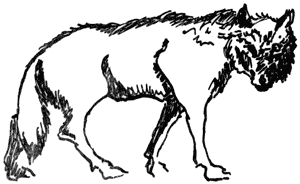 It is worthy to mention that I assisted in making a survey for a park waterline near this site last October. At that time the caretaker of Crater Lake Lodge, William E. Armstrong, told the naturalist that he and George Hopper, surveyor and former park engineer, had seen a large police dog within the park which apparently had gone wild. The location of this observation was not far to the south from the old boundary. It is possible that the animals in the two instances are identical.On Friday, January 10, Assistant Superintendent Parker reported that he had seen a huge timber wolf along the road near the old south boundary. The description passed on to me averred that his estimate of the size of the animal included: 125 pounds of weight and 18 inches high at the shoulder. On Saturday, January 11, I went down to the site of the observation to investigate. There were tracts of a canine animal which measured 3-/12 inches long, exclusive of the claw marks; the distance between tracks was 10-1/2 inches. A very light snow had fallen, so they could not be described as “fresh” tracks.
It is worthy to mention that I assisted in making a survey for a park waterline near this site last October. At that time the caretaker of Crater Lake Lodge, William E. Armstrong, told the naturalist that he and George Hopper, surveyor and former park engineer, had seen a large police dog within the park which apparently had gone wild. The location of this observation was not far to the south from the old boundary. It is possible that the animals in the two instances are identical.On Friday, January 10, Assistant Superintendent Parker reported that he had seen a huge timber wolf along the road near the old south boundary. The description passed on to me averred that his estimate of the size of the animal included: 125 pounds of weight and 18 inches high at the shoulder. On Saturday, January 11, I went down to the site of the observation to investigate. There were tracts of a canine animal which measured 3-/12 inches long, exclusive of the claw marks; the distance between tracks was 10-1/2 inches. A very light snow had fallen, so they could not be described as “fresh” tracks.
- The 1938 Index for 1928-1936 Nature Notes
- 01 Volume 1, No. 1, July 1928
- 02 Volume 1, No. 2, August 1928
- 03 Volume 1, No. 3, September 1928
- 04 Volume 2, No. 1, July 1929
- 05 Volume 2, No.2, August 1929
- 07 Volume 3, No. 1, July 1930
- 08 Volume 3, No. 2, August 1930
- 09 Volume 3, No. 3, September 1930
- 10 Volume 4, No. 1, July 1931
- 11 Volume 4, No. 2, August 1931
- 12 Volume 4, No. 3, September 1931
- 13 Volume 5, No. 1, July 1932
- 14 Volume 5, No. 2, August 1932
- 15 Volume 5, No. 3, September 1932
- 16 Volume 6, No. 1, April 1933
- 17 Volume 6, No. 2, July 1933
- 18 Volume 6, No. 3, August 1933
- 19 Volume 6, No. 4, September 1933
- 20 Volume 7, No. 1, July 1934
- 21 Volume 7, No. 2, August 1934
- 22 Volume 7, No. 3, September 1934
- 23 Volume 8, No. 1, July 1935
- 24 Volume 8, No. 2, August 1935
- 25 Volume 8, No. 3, September 1935
- 26 Volume 9, No. 1, July 1936
- 27 Volume 10 No. 1 – June 1937
- 29 Volume 10 No. 3 – August 1937
- 30 Volume 11 No. 1, July 1938
- 32 Volume 11 No. 3 – September 1938
- 33 Volume 12 – October 1946
- 34-2 Volume 13 – October 1947
- 34-3 Volume 13 – October 1947
- 35 Volume 14 – September 1948
- 36 Volume 15 – September 1949
- 37 Volume 16 – 1950
- 37-2 Volume 16 – 1950
- 37-3 Volume 16 – 1950
- 38 Volume 17 – 1951
- 38-2 Volume 17 – 1951
- 38-3 Volume 17 – 1951
- 39 Special Number 1 – 1951
- 39-2 Special Number 1 – 1951
- 40 Volume 18 – 1952
- 40-2 Volume 18 – 1952
- 40-3 Volume 18 – 1952
- 41 Volume 19 – 1953
- 41-2 Volume 19 – 1953
- 41-3 Volume 19 – 1953
- 42 Volume 20 – 1954
- 42-2 Volume 20 – 1954
- 42-3 Volume 20 – 1954
- 43-2 Volume 21 – 1955
- 43-3 Volume 21 – 1955
- 44 Volume 22 – 1956
- 44-2 Volume 22 – 1956
- 45 Volume 23 – 1992
- 45-2 Volume 23 – 1992
- 46 Volume 24 – 1993
- 46-2 Volume 24 – 1993
- 46-3 Volume 24 – 1993
- 47 Volume 25 – 1994
- 47-2 Volume 25 – 1994
- 48 Volume 26 – 1995
- 48-2 Volume 26 – 1995
- 48-3 Volume 26 – 1995
- 49-3 Volume 27 – 1996
- 49-2 Volume 27 – 1996
- 50 Volume 28 – 1997
- 50-2 Volume 28 – 1997
- 50-3 Volume 28 – 1997
- 51 Volume 29 – 1998
- 51-2 Volume 29 – 1998
- 51-3 Volume 29 – 1998
- 52 Volume 30 – 1999
- 53 Volume 31 – 2000
- 54 Volume 32-33 – 2001-2002


